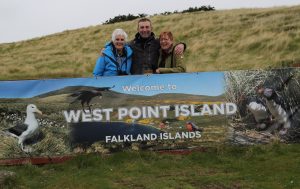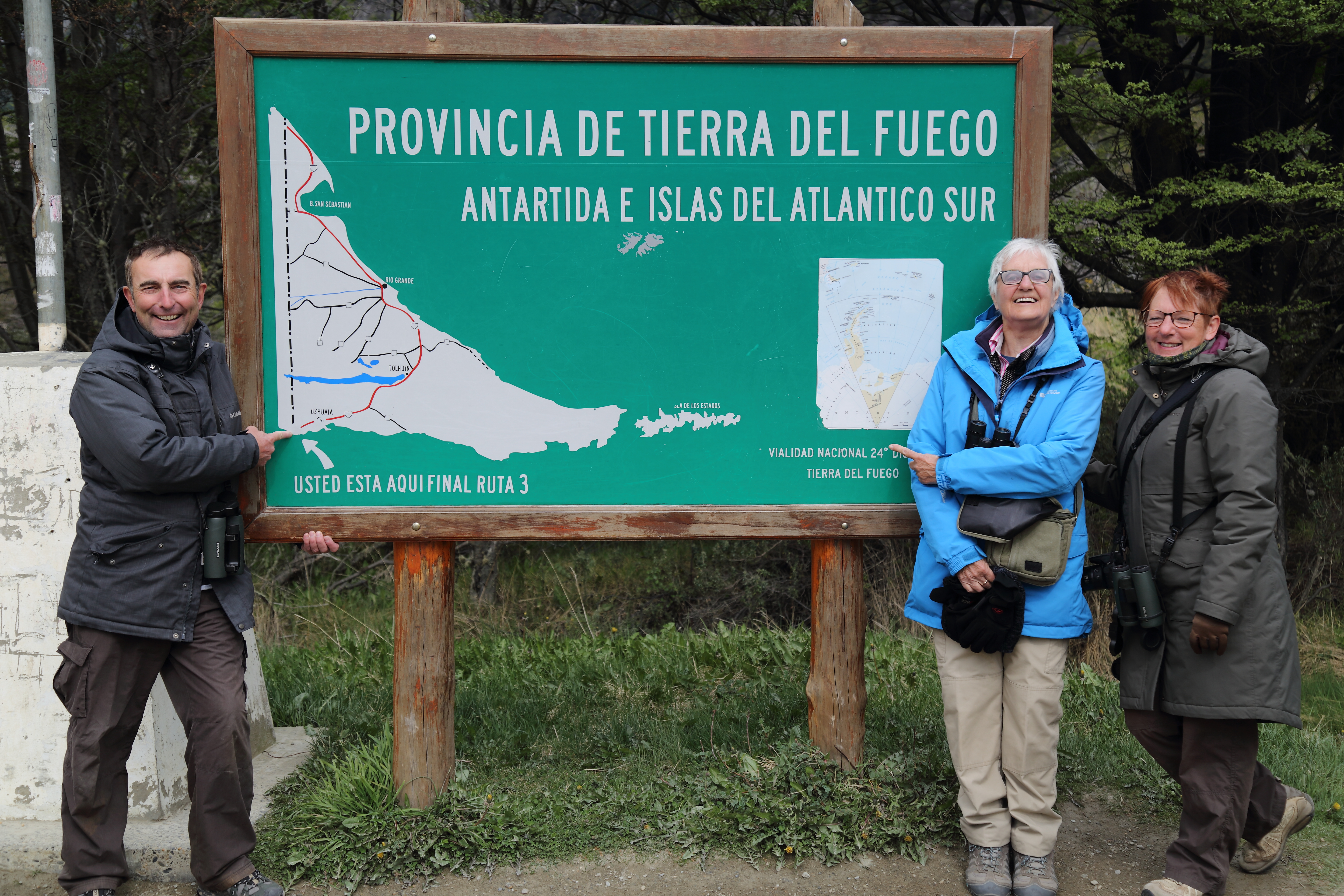We begin with a visit to the Costanera Sur reserve, beside the towering skyscrapers of Buenos Aires, where a steady stream of exotic water birds includes Rosy-billed Pochard, Brazilian and Silver Teal, Pied-billed Grebe, Neotropic Cormorant, Great and Snowy Egrets, Rufescent Tiger-Heron, Wattled Jacana, Pied Water-Tyrant and the strange Limpkin. An hour or so passes and we have barely moved, while adding many more species to the list such as Southern Crested and Chimango Caracaras, Eared Dove, Picazuro Pigeon, Monk Parakeet, Guira Cuckoo, Shiny and Bay-winged Cowbirds, Great Kiskadee, White-rumped Swallow, Brown-chested Martin, Rufous-collared Sparrow, and a sweetly-singing Creamy-bellied Thrush, as well as several Beaver-like Coypus. After a bag of chips from the Heroes de Malvinas snack bar, we enter the reserve proper, spotting the smart Golden-billed Saltator and a pair of Rufous Horneros going in and out of their ‘clay oven’ nest. Along the track heading deeper into the reserve, new birds include Tropical Parula, Glittering-bellied Emerald, Hooded Siskin, House Wren, Chalk-browed Mockingbird, Harris’s Hawk, Cocoi Heron, Southern Lapwing, Ringed Teal and a noisy flock of black-headed Nanday Parakeets. Meanwhile, a scan of the Laguna Gaviota reveals Black-necked and Coscoroba Swans, masses of Red-gartered, White-winged and Red-fronted Coots, a single Purple Gallinule and loads of White-tufted Grebes, plus a Maguari Stork and an enormous Southern Screamer. On the way back along the track we add White-eyed Parakeet to an impressive list for an afternoon stroll in a ‘big city park’.
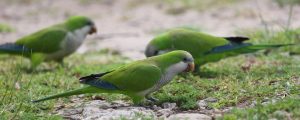
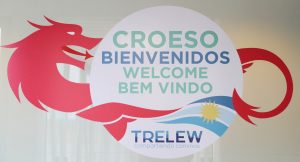
The welcoming words Croeso and Bienvenidos are not normally seen together, but here we are in ‘Welsh’ Patagonia, after a flight south from Buenos Aires to Trelew, where the sky is still blue as we head to the Lagunas del Ornitólogo on the outskirts of town. Despite the accumulating rubbish, this precious wetland teems with birds such as Kelp and Brown-hooded Gulls, Red Shovelers, Black-headed and Lake Ducks, Cinammon Teal, Yellow-billed Pintail, Chiloe Wigeon, White-tufted and Silvery Grebes, elegant South American Stilts and crowds of deep pink Chilean Flamingos. Amongst the pink-flowering Tamarisk bushes we also find Correndera Pipit, Fork-tailed Flycatcher, Chilean Swallows and a hovering American Kestrel. Next we visit nearby Gaiman, for afternoon tea accompanied by a varied selection of delicious home-made cakes, in a quirky Welsh tea house. On the edge of town, a pair of Burrowing Owls ‘kissing’ on a fence post makes a nice photo-opportunity. From here it’s a long drive north along what must be one of the world’s longest straightest roads, through the seemingly endless Patagonian steppe to Puerto Madryn, where we set sail for the Falkland Islands across the Golfo Nuevo, accompanied by awesome Southern Giant Petrels and several spectacular spouting Southern Right Whales, with extensive encrustations of barnacles all over their enormous heads.
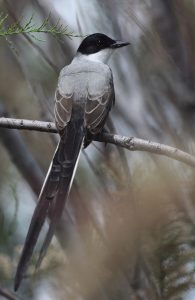
“We are 44° 49” south” announces the Expedition Leader at 7.45am this morning, as the ship heads purposefully south towards the Falklands. Throughout the day we are shadowed by plenty more Giant Petrels, while other sightings include Black-browed Albatrosses, White-chinned and Cape Petrels, Wilson’s Storm-Petrels, Greater Shearwater, Slender-billed Prion and South American Tern.
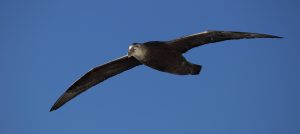
“Good morning. We are now 61.05 degrees south and heading for the Falkland Islands” announces the speaker at 7.45am this morning. It’s a beautiful sunny day and our old friends the Giant Petrels are still shadowing the ship, along with regular Black-browed Albatrosses and the occasional Cape Petrel and Antarctic Prion, plus a Brown Skua. It’s remarkable to conceive how far these long-lived birds must travel in a life time, as here they are, so far from land, that we have not seen anything other than seabirds for over two days! Land ahoy! Around 6pm the Falklands are spotted on the horizon, around 37 nautical miles away, while the ship is visited by bow-waving Peale’s and Dusky Dolphins. The sea here is dotted with tight-packed shoals of vivid orange Krill, attracting four Fin Whales, regularly spouting plumes of spray as high as a house!
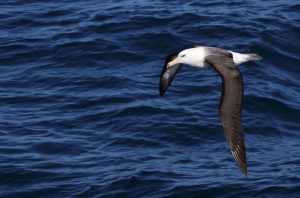
It’s a beautiful calm, cloud free sunny morning, perfect for going ashore on Carcass Island, which looks like it could be off the west coast of Scotland, Ireland or Wales, complete with bright yellow patches of Gorse, were it not for the exotic birdlife along the shore, including plenty of Kelp Gulls, Kelp Geese and Blackish Cinclodeses, along with Crested Duck, Snowy Sheathbill, Blackish Oystercatcher, a trio of piping Magellanic Oystercatchers, posturing noisily with bowed heads and erect tails, and a couple of pairs of chunky flightless Falkland Steamer-Ducks, quietly snoozing on the seaweed-covered rocks. Immediately inland from the rocky shore, more new birds await, such as Upland and Ruddy-headed Geese, Austral Thrush, Long-tailed Meadowlark, Black-chinned Siskin and the swaggering ‘bully boy’ Striated Caracara, followed by tea and cakes at the local homestead.
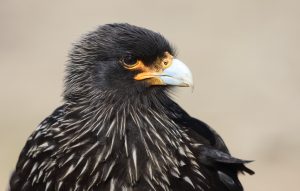
This afternoon, we visit ‘uninhabited’ Steeple Jason. Porpoising Gentoo Penguins accompany the Zodiacs into shore, where huge South American Sea Lions haul out on the rocks by the landing point, while a ‘small’ colony of a thousand or so Gentoo Penguins huddle together under the watchful eyes of Brown Skuas. The Gentoos are a warm up act for the main event, which is the huge colony of Black-browed Albatrosses, jam-packed with thousands of these drop dead gorgeous birds, sitting atop mud pillar nests, and bleating like corralled sheep, while thousands more fill the sky all around the island. Garrulous Rockhopper Penguins also nest amid the organised bedlam, overseen by Striated Caracaras, watching like hawks while waiting to pounce on any opportunity for a free meal. What an absolutely awesome and unforgettable spectacle.
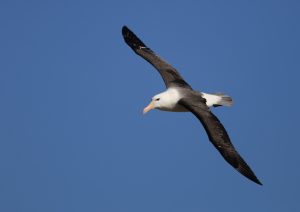
Three two tone grey Peale’s Dolphins escort the Zodiacs as we approach the red-carpeted jetty on West Point Island, where the welcoming party includes the usual Kelp Geese as well as a family of Ruddy-headed Geese with three tiny downy chicks. On the short yomp across the island to Devil’s Nose, land birds include Austral Thrush, Dark-faced Ground-Tyrant, Black-chinned Siskin, Grass Wren, the exotic strawberry-fronted Long-tailed Meadowlark and House Sparrow! At Devil’s Nose, a mixed colony of Rockhoppers and Black-browed Albatrosses allows remarkable face to face views of these stunning birds in fabulously crisp clear light. Wow!
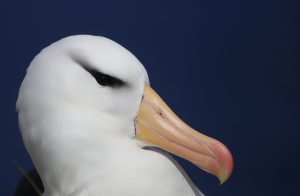
This afternoon, it’s a beach landing on Saunders Island, where we join the handsome Dolphin Gulls, plus Gentoo Penguins in their hundreds, watched over by Brown Skuas. A short walk leads to a second beach, where a small group of resting King Penguins includes a couple of ‘wooly bear’ juveniles, still in their thick brown ‘fur’ coats. The grassy slope inland from the beach is riddled with the burrows of Magellanic Penguins, while a rocky headland a little further on houses another colony of Rockhoppers, along with Billy, a lone Macaroni Penguin having a very ‘bad hair day’, making five different species on one small island! Also amongst the Rockhoppers are really smart looking Imperial Cormorants, with deep blue eye rings, and scavenging Snowy Sheathbills, looking like a cross between a chicken and a pigeon!
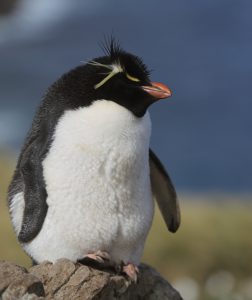
There is sadly too much swell this morning for a beach landing at Volunteer Point, so no more King Penguins today. Heading south for Port Stanley, there are plenty of Sooty Shearwaters and South American Terns, as well as a Grey-headed Albatross, a Southern Fulmar, some spouting whales and four Peale’s Dolphins riding the bow wave just beyond the spray from the ship’s bow. This afternoon we visit Port Stanley, with its unusual juxtaposition of Magellanic Cormorant, Dolphin Gull and House Sparrow!
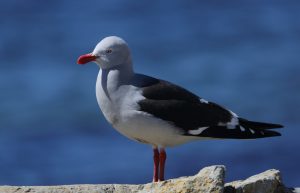
After many days of blue skies, today’s fifty shades of grey, 45 knot winds and a heavy swell make a beach landing on Bleaker Island inadvisable, and so we continue west hoping for better weather at Sea Lion Island, where the sky turns blue again, but the swell is still too high for a landing, so the Elephant Seals on the beach are mere specks! Next we steam north along Eagle Passage, accompanied by South American Terns and Southern Fulmars.
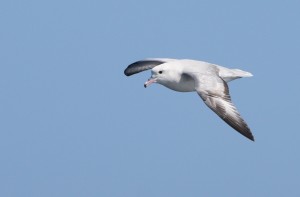
After a night of heavy rock ’n’ roll, we anchor off the south side of New Island in the sunshine again. From the beach, with the ubiquitous Kelp Geese, Magellanic Oystercatchers and Crested Ducks, a short walk with Austral Thrushes, Dark-faced Ground-Tyrants, Long-tailed Meadowlarks and families of Upland Geese, attracting a swooping Red-backed Hawk, leads to another noisy colony of squabbling Rockhoppers, while Imperial Cormorants whizz by at eye level. On the stroll back, we even find a Rabbit nibbling the Gorse! Back at the landing beach, three Black-crowned Night-Herons are roosting in the shell of an old shipwreck, Magellanic Cormorants are resting on the rocks exposed by the low tide, and a pair of Two-banded Plovers is new for the trip list. Sadly, it’s time to leave the Falklands, and as the cliffs of West Falkland recede beyond the horizon, the usual posse of Giant Petrels following the ship, is joined by Cape Petrels, hundreds and hundreds of Antarctic Prions and a majestic Southern Royal Albatross.
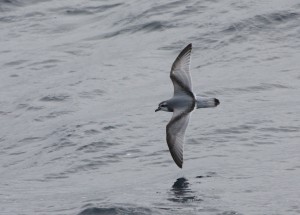
“The sea’s not good, but not bad!” announces the Captain this morning. With a Beaufort force 9 severe gale, 40 knot winds and 15 to 18 foot waves, we are confined to the inside of the ship, which crashes through the waves with a booming sound, while spray inundates the bow deck, visible from the cabins thanks to the bow camera. It’s late afternoon by the time it’s safe to venture out on deck, with the tumultuous white horses on the sea mirroring the rugged snow-capped peaks of Tierra del Fuego. Being so near to Cape Horn there are hordes of Cape Petrels alongside the ship, as well as a couple of Southern Royal Albatrosses, and just before dinner a Grey-headed Albatross joins the party, at times too close for the cameras!
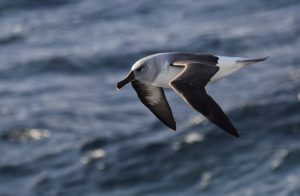
So here we are at the end of a fantastic cruise, in the port of Ushuaia, Argentina’s southernmost city, along with Chilean Skuas, and no wind! Once inside the nearby Tierra del Fuego National Park, which looks and feels like a scaled up version of the Scottish Highlands in March, new birds include Ashy-headed Geese, Black-faced Ibis, Bar-winged Cinclodes, White-crested Elaenia and Patagonian Sierra-Finch. The Southern Beeches here represent the world’s southernmost forest, and many of the gnarled old trees look like they have been strafed with heavy machine gun fire, which is the work of the mighty Magellanic Woodpecker, the largest woodpecker in the Americas, and our number one target bird. Strolling along a trail beside Lago Roca, we eventually stumble upon a pair of these impressively large woodpeckers, going about their business, bold as brass, including mating, completely unperturbed by our nearby presence! As they hammer seven bells out of the tree trunks within a few yards at eye level, we get awesome views of both birds. The all black female has yellow eyes, a red face and a long forward curling black crest, while her partner has a stunning scarlet hood with a Teddy Boy’s quiff. What a show, followed by high fives all round. After a picnic lunch with tame Rufous-collared Sparrows and Patagonian Sierra-Finches, another stroll produces close views of Dark-faced Ground-Tyrant and the aptly named Fire-eyed Diucon, with glowing ruby eyes. Journey’s end is El Fin del Mundo, Argentina’s Land’s End, where the Pan-American Highway becomes a dusty car park, almost 2000 miles from Buenos Aires, with two Andean Condors soaring along a rocky ridge on the sky line. Other new birds here include Austral Blackbird and the tiny Tufted Tit-Tyrant. We end the day in this fabulously scenic national park at a coastal fiord on the rugged border with Chile to the west, spotting Dark-bellied Cinclodes on the shingle beach, a male Flightless Steamer-Duck just offshore, and a pair of Treecreeper-like Thorn-tailed Rayaditos in the woods along the shore. The birding continues outside our coastal hotel with Chiloe Wigeon, Southern Lapwings, Baird’s Sandpipers, Black-crowned Night-Heron, Chilean Swallows and the delightful little black-and-tan Austral Negrito, while hundreds of Kelp and Dolphin Gulls gather to roost for the short night ahead.
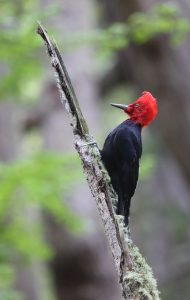
With a fresh dusting of snow on the surrounding peaks, we begin at the not so scenic rubbish dump on the outskirts of Ushuaia, which attracts hordes of Kelp Gulls as well as three species of Caracara; Chimango, Southern Crested and the target White-throated, which is new for the trip. From here we head north towards Rio Grande, along National Route 3, through the spectacular snow-capped Darwin Range at the southern end of the Andes, spotting Flying Steamer-Ducks and Speckled Teal along the way. At a mirador overlooking Lake Fagnano, an Andean Condor slowly glides directly overhead, as if using the southern shore as a landmark back to its mountain ‘hideout’. The eastern tip of this long ‘finger’ of freshwater, ends at a windswept shingle beach, some 70 miles inland, where we encounter the incredible sight of a Grey-headed Albatross sailing back and forth along the beach, rather than wanting to continue across dry land. This sighting is so remarkable that our guide is incredulous, and even more gobsmacked and excited than we are, and immediately phones a friend to convey the news! However, the albatross is not the only lost ‘sailor’, as there is also an Antarctic Prion in the same ‘boat’! Moving on, the first of many Guanacos, a member of the camel family, appears in the increasingly open grassy landscape.
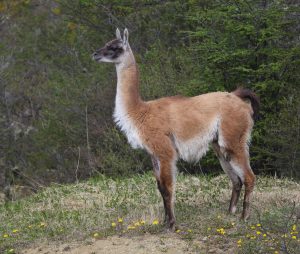
After lunch, a second condor passes by at close range, while new birds around the town of Rio Grande include Rufous-chested Dotterel, Lesser Yellowlegs, White-rumped Sandpiper, Short-tailed Miner, and several very showy Least Seedsnipe, along with several families of Two-banded Plovers with tiny fluffy chicks.
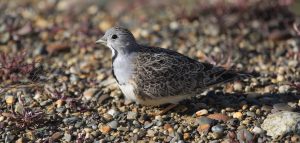
It’s another windy day, beginning along the shore at high tide, with plenty of Snowy Sheathbills and a Turnstone. Driving inland through a rolling treeless grassy landscape, stretching as far as one can see, we pass the world’s largest sheep shearing ‘shed’, with more ground space than a football pitch, en route to the remote Estancia Los Flamencos. The large shallow lagoon here has all but evaporated, leaving a layer of salt crystals on the dry, cracked mud, with no flamingos, although we manage to locate a regionally endemic Magellanic Plover quietly incubating at least one egg on the stony shore. Other new birds here include Common Miner, Cinnamon-bellied Ground-Tyrant, a couple of pairs of Ruddy-headed Geese amongst a flock of Upland and Ashy-headed Geese, and a very smart Tawny-throated Dotterel, with yet another condor soaring above. Back in Rio Grande, four Rufous-chested Dotterel show really well.
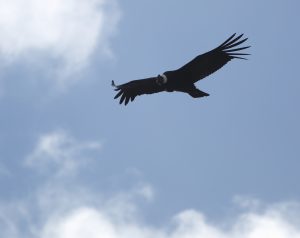
After a night of Tango in Buenos Aires, we are back at the international airport, where sightings from the terminal windows include House Sparrow, Chalk-browed Mockingbird, Chimango Caracara and Grey-breasted Martin, which is new for the trip, bringing the list to 143 species including top drawer birds like Falkland Steamer-Duck, Striated Caracara, Magellanic Plover, Andean Condor, three species of Albatross, five species of Penguin, and of course the fabulous Mr and Mrs Magellanic Woodpecker.

